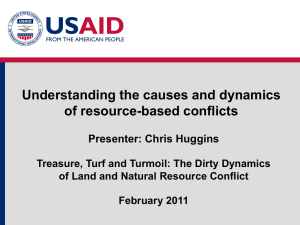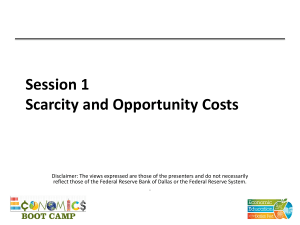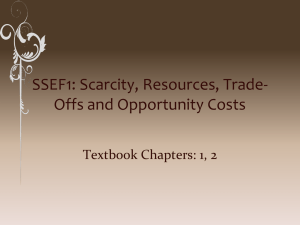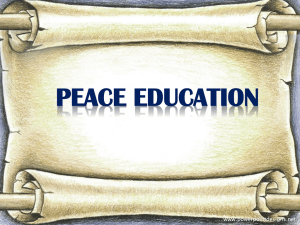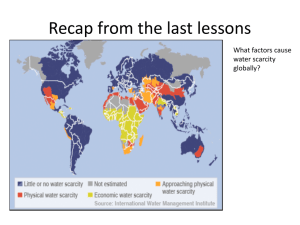Support and guidance - Unit 3, topic 2 : Water Conflicts
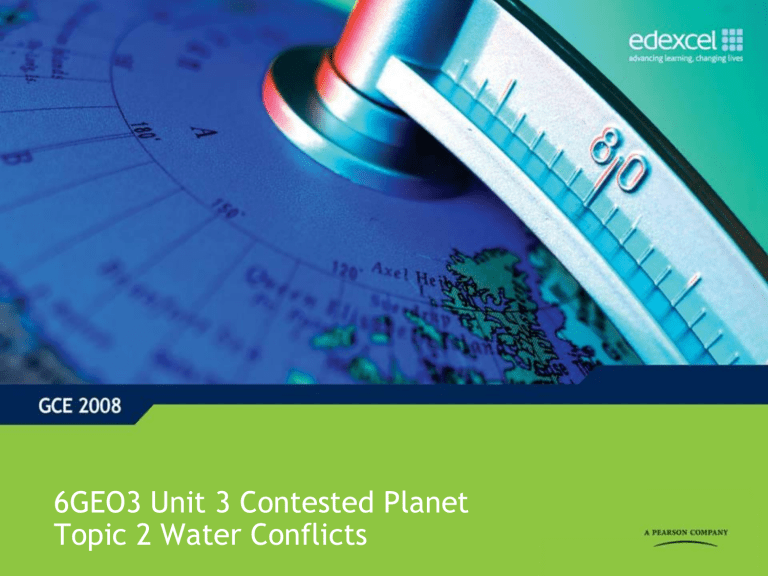
6GEO3 Unit 3 Contested Planet
Topic 2 Water Conflicts
What is this topic about?
•
Water Conflicts is the second of the ‘resources’ topics
•
It examines the range of conflicts associated with the supply and demand patterns of the fundamental resource of water.
•
Water supplies and quality vary globally, and actual and potential conflicts arise from the gap between growing demands and diminishing supplies.
•
There are also growing pressures resulting from climate change
Mega technological fixes for mega problems
(Hoover Dam, USA) versus Low tech solutions (Taanka storage of India)
CONTENTS
1.The geography of water supply
2. The risks of water insecurity
3. Water conflicts and the future
Click on the information icon to jump to that section.
Click on the home button to return to this contents page
2. The risks of water insecurity
•
What are the potential implications of an increasingly ‘water insecure’ world?
Water supply problems
Increasing water shortages may be more important than energy shortagesbecause there is no alternative!
Water conflicts
Where demand exceeds supply and no effective management operates, then there will be conflicts between the various players involved
Water geopolitics
The conflicts between nation states, despite the international agreement called the Helsinki
Rules designed to create more equitable use of water extending across boundaries
Water transfers
Of this precious resource by either diverting the actual river, or using canals . Long carried out at a small scale but increasingly over larger distances, and even transboundary
1.The geography of water supply and demand
• River systems transport this water, often at continental scale.
• Flows increase downstream as tributaries enter.
• Seasonal changes in temperature can create distinctive river regimes.
• The relationship between water inputs and outputs is water balance
Climate
• Climatic zones are critical in determining water availability
• Equatorial / tropical areas have higher rainfall than temperate / arctic areas.
• High altitude areas have snowpack water reserves released in late spring.
• Monsoon areas have one main peak, equatorial areas two peaks.
• Some tropical areas experience recurring drought
Physical influences on water supply and scarcity
97.2%
Ocean & saltwater
Geology
• Surface drainage occurs on rocks which are impermeable such as granite and clay.
• Permeable rocks like limestone, chalk and some sandstones store water, called aquifers.
Flood management + dam construction affect channel flow + storage
Human influences on water supply and scarcity
•
Humans affect the hydrological cycle at many points of flows and storage:
By Quantity
( adding to or abstracting) or
Quality(pollution ) Land use changes affect interception + infiltration + surface storage;
Eg urbanisation, deforestatio n
Disruption of water cycle
Water abstraction affects ground water storage, and can create salinisation and salt water incursion
• Blue water flow is the visible part of the hydrological system: surface flows and then recharging aquifers
• Green water flow is water intercepted, stores and released by vegetation by evaporation and transpiration
• Grey water is polluted water
Supply can be from:
Surface sources
groundwater sources
In the UK 2/3 of supply is from surface and 1/3 from groundwater, with regional variations.
• Freshwater is effectively a finite
resource since only about 1% of freshwater is easily available for human use.
• The water footprint indicates how much is required by consumers- and in an increasingly globalised world, the footprint of someone in a country like the UK will not be just local as so many products using water will have been produced elsewhere!
Some key definitions
Water shortage
Water stress
Water scarcity low level of water supply relative to basic needs.
often taken as less than
1700m3 per person per year supply of water per person falls below
1000m3/year
Physical water scarcity
Economic water scarcity reached when 60% of river flows are diverted for agricultural, industrial & municipal purposes; globally over
75% is now used when less than 25% of rivers are used, and there is abundant supply potential: water does not reach the poorest people measured by annual renewable flows (in cubic metres) per head of population, or the number of people dependent on each unit of water
•growing conflict between users and competition for water
• declining standards of reliability and service
• harvest failures and food insecurity.
Domestic
•a high rate of use compared to available supply, especially if the remaining supply is difficult or costly to tap.
Physical water scarcity is shown by:
• Severe environmental degradation
•Declining groundwater and water allocation which favours some groups over others.
•Arid and semi-arid areas are most at risk
This is often due to political reasons and conflict: easiest to solve by low technology solutions: small dams, water harvesting from roof tops etc. It is targeted by NGOs like Water Aid
Water scarcity hotspots
According to the International Water Management
Institute environmental research organisation global water stress is increasing, and 1/3 rd of all people face some sort of water scarcity. Agricultural uses dominate in the growing need for food.
Egypt imports > 50% of its food because of physical scarcity
Aral Sea faces environmental catastrophe, although recent attempts to reduce impacts of river diversions for especially cotton production
Severe water scarcity N China, leading to South North transfer scheme-see later slide
Ogallala aquifer provides 1/3 all US irrigation water, but is seriously depleted: the water table is dropping by about 1m/yr.
As a ‘fossil’ reserve, formed probably from past glacial meltwater flows, it is effectively a finite resource
R Ganges: physical stress from pollution and over abstraction
Australia; diversion ¼ of all water away from Murray Darling
Basin for agriculture
Much of sub Saharan Africa suffers from economic scarcity from especially poverty but also lack of infrastructural development . Some
1 bn people involved1
Little/no water scarcity
Physical water scarcity- not necessarily dry areas but those where over 75% river flows are used by agriculture, industry or domestic consumers
Economic water scarcity- less than 25% rivers used, and abundant supply potential but not reaching the poorest people .
Approaching physical water scarcity – More than 60% river flows allocated, and in the near future these river basins will have physical scarcity
Water conflicts
Population growth
Consumer demand
Industrial growth
Agricultural demand
DEMANDS?
Rising
SUPPLY?
Diminishing
Reductions because of:
• Users abstracting/polluting upstream
• Deteriorating quality
• Impact of climate change
DIFFERENT
USERS?
Conflicting demands
• International conflicts i.e. basin crosses national boundaries
• Internal conflicts ie within a country
• Conservation versus exploitation
PRESSURE POINT- ie need for management.
This is shown spatially as a ‘hotspot’ of conflict, see map on next slide.
Pressure and hence tension and conflict may be over surface flow and/or groundwater supplies
Dams and diversions and loss of wetlands are particularly contested.
Present and potential water conflict hotspots
• As water supply decreases, tensions will increase as different players try to access common water supplies
• Many conflicts are transboundary in nature, either between states or countries
River basins currently in dispute
River basins at risk in the future
Tigris-Euphrates
Iraq + Syria concerns that
Turkey’s GAP project will divert their water Ob
Large International drainage basins
Colorado: disputes between the 7 US states and Mexico it flows through. The river is so overused, that it no longer reaches the sea!.
90% abstracted before reaches
Mexico
La Plata
Lake
Chad
Note: although there have been rising tensions globally, many areas demonstrate effective management to diffuse the situation and create more equitable and sustainable demand-supply balance, such as the Mekong River Committee,& the Nile River Initiative
Okavango Zambezi
Ganges
Nile hotly disputed between Ethiopia and
Sudan ,who control its headwaters, and Egypt .
Mekong
The Aral Sea, an inland drainage basin, once the world’s 4 th largest inland lake has shrunk sine the 1950s after the 2 rivers feeding it: the Amu
Dayra and Syr Darya were diverted for irrigation.
By 2007 the sea was
10% of original volume and split into 2 lakes.
The ex soviet states are in conflict:
Uzbekistan ,
Turkmenistan and
Kazakstan.
History of hydropolitics in Nile Basin
•tensions due to the dominance of Egypt
• civil wars in Sudan
Ethiopia
• tensions from Egypt’s treaties dating back to the
1929 and 1959 Nile Water
Agreements.
• Upstream states increasingly challenging
Egypt’s dominance.
•Ethiopia wants to use the
Nile River for HEP plants and industrial development.
Hydropolitics and geopolitics
Political negotiations centred on conflicts over the shared use of water sources
• The Nile is the world’s longest river , 6,500kms,
2.9km2 catchment,10% of Africa, running through
10 countries with 360 million people depending on it for survival.
• Growing issues of desertification & salination and increased evaporation linked to climate change
• About 85 % water originates from Eritrea and
Ethiopia, but 94 % is used by Sudan and Egypt.
Evidence of more effective co-operation
• The Nile Basin Initiative, system of cooperative management which started late 1990s
• All countries except Eritrea working with
The World Bank and bi-lateral aid donors .
• Community level involvement .
• Managers visited Colorado River recently to see how effectively the 1922 River Water
Compact and its ‘law of the river’ works
Tech Fix ;
The megaprojects of dams like Aswan are famous.
Latest high tech is the
1990sproject called
‘Tecconile’ a joint GIS system to help monitor and plan the basin
• 1996 Helsinki Rules on the Uses of the
Waters of International Rivers - regulating how transboundary rivers and groundwater are managed
• The Nile Basin is an example that ‘Water
Wars’ may be averted
Source area
Water transfers- a quick fix?
Receiving area
Less water
• Leads to reduced use by locals, may increase poverty
More water
• Solves existing demand
• leads to greater use
Ecosystem changes
• Degradation/ destruction
• Less functioning
• Less productive
Development demands
• Rising megacities and Industrial growth
• tourism especially golf courses
• Improved human health
Pollution
• Less dilution
• More concentration of pollutants
• More silt
Agricultural demands
• Encourages unsustainable irrigated farming by agribusiness
Pollution
• Pollution from nitrate eutrophication and salination
• Transfers pollution from original river to new location
• Ecosystem destruction
I nternational
Examples of existing schemes
Lesotho to South Africa:
Lesotho Highlands Water
Project
Turkey to Israel by tanker
National:
Snowy Mountains-Australia
Melamchi Nepal
Tagus-Mercia Spain
Proposed schemes
International
Turkey to Israel undersea pipelines
Austrian Alps to Spain +
Greece by pipeline
National:
South-North transfer- China
Ebro -Spain
Ob to the Aral Sea
NAWAPA Alaska to California
Mega Tech Fixes: China’s South–North water transfer
Demand from industrial centres, high population density and intensive agriculture. Low rainfall and over abstracted groundwater: physical scarcity
Externalities
• Industrial growth along routeways will exacerbate existing pollution problems
• Changes in water balances: reduced water in Yangtze means less dilution and more pollution
• Displaced people especially from Dang Jiang
Kou dam ......
Western
Routes
Work starts
2010, at high altitude, very difficult
500kms at 3-
5000m above sea level
Yellow
River
Central routes
1267 km diversion. May have to use some water from 3 Gorges reservoir to help
CHINA
Yangtze River
Beijing
Tianjin
Eastern
Route
1,155km long diversion
Shanghai
One of the largest water transfers globally .
Aim: to divert
45bn m3/year from the water surplus river basins of the S and E to the water deficit areas of the North, especially
Beijing and
Tianjin
0 mls 250
South China
Sea Originally planned 1952, started 2002 ,due to finish 2050. Chief player :
Government sponsored ‘South to North Water Transfer Project Company, with each province having a local water company. Involves huge civil engineering works, 3 major canals, pipelines, tunnels, pumping stations
In the Northern region: Turkey is in dispute with Syria and Iraq over damming more of the
Tigris and Euphrates river
In the Western
Region: Israelis,
Syrians,
Jordanians and
Lebanese are all in dispute over shrinking water supplies
A contributory factor to the 1967 Arab-
Israeli war
Water storage is in 3 huge aquifers under the Israeli mountains and coastal strip and the
R Jordan
Water issues in the Middle East
The Aral Sea, on the boundary of the Middle East and Asia is suffering from over abstraction and pollution
• There are significant disputes over access to water already in this area
• The combination of a growing population and low seasonal rainfall are the main causes.
• Is the energy dependent technological fix of desalination the answer?
• Photo of a plant in
Dubai
3. Water conflicts and the future
What are the possible conflicts and solutions to increasing demands for water?
This section looks at 4 themes, and the table below summarises three scenarios for the future
1.
2.
3.
4.
Trends in water demand globally and locally
Water players
Responses to need to increasing water supply and the issues these strategies raise
The role of technology in water supply
Business as usual
The cost of water will increase
Water consumption will increase resulting in declining stores
Food transfers will mitigate shortage of water in areas where agriculture declines
Water Crisis Demand will outstrip supply
The proportion of the world’s population without access to clean water will increase
Food insecurity and migration will increase
Conflicts of water supplies (intra and inter state) become more likely
Sustainable
Water
Agricultural and household water prices will double in the developed world and triple in the developing world
Global water consumption will fall, although the gap between per capita use will close
Green water flows will increase
Improvements in water harvesting and farming techniques allow food yields to increase whilst water consumption declines
From: 2002 International Food Policy and Research Institute future models
World Water Days- trying to be more sustainable?
• The importance of water in managing global issues is shown by the profile given to it by the UN:
• It declared 2005 to 2015 as the International Decade for
Action, "Water for Life”.
• Every year on March 22 nd the UN gives a theme to publicise current issues. 2010 World Water Day: dedicated to the theme of water quality.
• Such global action is rooted in the iconic Earth Summit on Environment and Development (UNCED) in Rio de
Janeiro in 1992, and the creation of Agenda21 (the
Blueprint for planet management at global scale)and
Local Agenda 21( global problems, local action)
Previous Themes for World Water
Days
• 2009 Transboundary water
• 2008 Sanitation
• 2007 Coping with water scarcity
• 2006 Water and Culture
• 2005 Water for Life
• 2004: Water and Disasters
• 2003: Water for the Future
• 2002: Water for Development
• 2001: Water and Health
UN MDG TARGET set in 2000: Halve, by 2015, the proportion of the population without sustainable access to safe drinking water and basic sanitation.
The world is ahead of schedule in meeting the 2015 drinking water target.
Yet a number of countries face an ‘uphill battle’: 884 million people still rely on unimproved water sources for their drinking, cooking, bathing and other domestic activities.
Of these, almost 85 % (746 million people) live in rural areas .
1990 to 2006, 1.1 billion people in the developing world received access to toilets, latrines and other forms of improved sanitation.
But this leaves 1.4 billion people still needing such facilities if the 2015 target is to be met.
Water Players and decision makers
• Different players have conflicting views on water insecurity
• One player may have quite complex views; most Governments will have departments wanting conservation as opposed to development
• You need to identify the ‘stakeholders’ in any particular case study, and then the role of the ‘gatekeepers’ who wield power. The next slide shows a classification of players
Political: water is a human need
• International organisations e.g.
UN
• Government
• Regional & local councils
• Lobbyists & pressure groups
Social: water is a human right
• Individuals
• Residents
• Consumers land owners, health officials, NGOs like Water Aid
Photograph of Aral Sea with grounded tanker
Environmental
• Conservationists
• Scientists & planners
Economic
• International:
World Bank & IMF
• TNCs and developers
• Businesses and users
Classifying the water players
Political Economic Social Environmental
Global
National
Local
World Bank funds megaprojects to improve supply. Has become more environmentally conscious. This group also has businesses and TNCs
UN Millenium Development Goal called The Water Target:"Halve, by 2015, the proportion of people without sustainable access to safe drinking water and basic sanitation "
World Health Organisation
G8 Summits : 2002 Evian action Plan, focus on water, and 2009 L’Aquila summit increased aid to poorer countries to help MDGs, + highlighted need for more integrated management
Government owned water companies, eg China
TNCs (Viendi and
Suez RWE which owns Thames
Water, American
Water Works
Companies providing technological fixes
The role of NGOs such as Water Aid
or GLOWS has been crucial in managing water supplies
Countries such as
India, have mounted successful massive communityled campaigns on things like elimination of open defecation
Government
Health Agencies from national to local scale
WWF and
Friends of the
Earth campaign for full Environmental
Impact Assessments of major projects likely to damage the environment
This group will include many scientists and researchers
At a local scale
NIMBY groups will campaign
Individual 6.9 billion consumers
Responses: Management strategies
• Water conflicts can be managed in a range of different ways
• There is a spectrum of different management strategies
• Some are sustainable as they balance ecological and human needs
What is
Sustainability?
Millennium
Ecosystem
Assessment definition:
A characteristic or state whereby the needs of the present and local population can be met without compromising the ability of future generations or populations in other locations to meet their needs.
Present policies
Driven by short term economic + political concerns
Often do not include science and effective technology
Strategies rely on technology?
Obstacles to sustainable management
•Climate change uncertainty and effects
•Natural variability of water
•Pressures caused by human activities and rapid growth of transition economies towards a consumerist society
•Increased water demands
•Gross inefficiencies in use
•Poor existing quality of supply across huge areas of world
•Funding
•Access to appropriate technology
Future policies?
Longer term?
Need more research, information and monitoring especially on aquifers in developing countries
More partnerships?
More community involvement?
More accountable?
• Water management often focuses on large scale, technologically advanced megaprojects
• These often have complex costs and benefits
• Water conservation and restoration of supply have a role
• Small scale, bottom-up schemes are likely to be important in the developing world
• However, unless duplicated on large scale may be ineffective for longer term economic growth
Low tech solutions to water : a case study
The problem : The River WAKAL area of Rajasthan in NW India is one of the driest and poorest areas in India. Subsistence agriculture dominates.
96% of rainfall is from the 3-4 month monsoon (late June through
September.) and the traditional methods of using groundwater and conserving surface water are falling short of demands
A solution? Basic technology and information is channelled through the NGO:
GLOWS( global water for sustainability project) a partnership between World Vision
India and Florida International University.
Methods:
1. Increasing simple low tech appropriate and intermediate solutions to increase storage:
•Increased rainwater harvesting
•Improved storage system at a family scale:
Taankas : 3 m in diameter , 3-4 m deep, most below land level with a side opening to allow surface flow in. They store about
20,000litres, and once full provide water for a family until next monsoon.
2. Using colourful drama performed by trained locals to villagers to illustrate the advantages of working cooperatively with other families and villages to reduce desertification and pollution of ground water by since aquifers are shared-if an unseen resource! (see photgraph)
Changes : Traditional low tech methods of water conservation.: stone dams, Persian water wheels and tube wells- but cannot cope with increased demand and increased droughts
Hard and soft management
How to meet the challenge of the need for more water?
Traditional ‘hard’ engineering
• Dams; currently 845000 of which 5000 classed as megadams. The aim is to increase natural storage capacity by artificial reservoirs. Rivers most at risk at present: Yangtze, Amazon, Danube and many in the
Himalayas
• Channels, seen in most arid/semi arid countries whatever their economic status, eg Jonglei Canal on
Nile
• Pipelines eg Australia and California Aqueduct and snowy Mountains scheme Australia
• Desalination plants eg in Middle East
• Recharging schemes for depleted aquifers, eg North
London Artificial recharge Scheme and Long Island New
•Tankers to transport water eg turkey to israel
•Osmosis membranes filtering salt from brackish water eg Israel (the Ashkelon plant produces 15% of domestic demand). Also in
California, Spain and China
•Fertigation: fertilser and water drip feeding of crops, as in Israel
Softer more environmentally and ethically responsible approaches
• Water conservation eg targeted drip irrigation on plants in Ethiopia, includes water harvesting
• Water restoration eg Northern Aral
Sea, and on smaller scale river
Colne in UK
• Integrated drainage basin management , especially if bottom up and community involved.
• The 4 Rs: ie an attitudinal fix:
Reduce, Respect, Reuse, Renew.....
Specific Technologies seen as appropriate /intermediate with less negative externalities
•Water harvesting of grey water eg Belize
•Micro dams serving villages eg Nepal
•Water meters to reduce use eg UK
•Composting latrines – seen in National Trust properties in UK to Mumbai slums!
Water Conflicts overview
Water Resources
• Water like energy is a fundamental need but not evenly distributed
• Factors influencing geography of supply:
Physical-surface, groundwater, desalinisation
Human: demand, management, mismanagement
• Increasing demand not matched by supply= WATER
GAP
• Implications for human well being- which is why it is named in the MDGs
• Demand from various users
• Water resources are often transboundary
Water Conflict
• Potential conflicts=high both local & international
• Resource use often exceeds recharge capacity leading to long term degradation
• Future is in doubt because of unsustainable use+ climate change
• Vulnerable populations most at risk
• Management strategies to ensure supply require cooperation of many different players = changes in way water is valued & used
Water Futures
Water stress and scarcity are projected to increase because:
•
Climate change will make some areas more arid and rainfall more unreliable
•
Glacial water sources will reduce due to climate change
• Unsustainable use of some supplies will decrease their quality and quantity
• Demand will rise due to population and economic growth
• Water wars will lead to winners and losers in water supply
Therefore, there are alternative futures –
It all depends on the decisions the players make....
and climate change, population trends, energy security, superpower politics, bridging the development gap etc
…
22
Synopticity-Water-Energy
• Energy and Water: Solving Both Crises Together:
•
Water and energy are the two most fundamental ingredients of modern civilization
•
We consume massive quantities of water to generate energy, and we consume massive quantities of energy to deliver clean water
• Peak Oil is topical. Peak Water or ‘Blue Gold’ is less thought about.
There are tensions between the two: water restrictions energy problems, particularly rising are hampering solutions for prices, are curtailing generating more efforts to supply more clean water.
energy
• An issue in energy rich states ,which are semi arid/arid: to sell cheap oil or keep to power desalinisation plants
• Water is needed to generate energy. Energy is needed to deliver water. Both resources are limiting the other—and both may be running short. Is there a way out?



